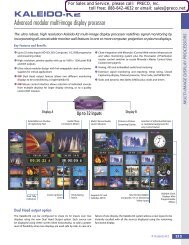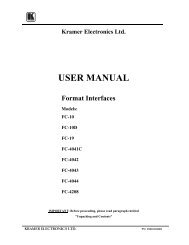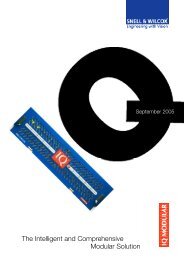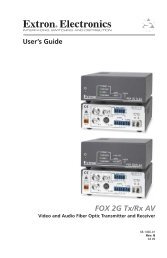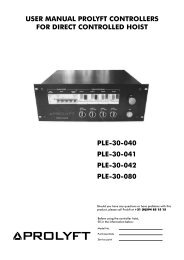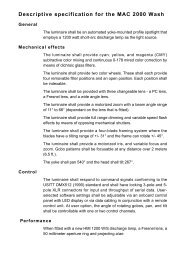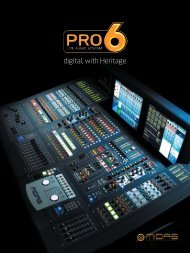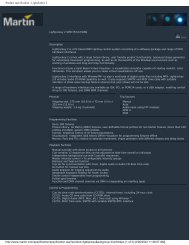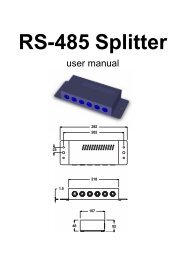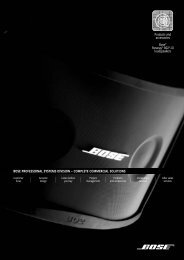WBS-670 WBS-680 WBS-670 WBS-680
WBS-670 WBS-680 WBS-670 WBS-680
WBS-670 WBS-680 WBS-670 WBS-680
You also want an ePaper? Increase the reach of your titles
YUMPU automatically turns print PDFs into web optimized ePapers that Google loves.
systems<br />
and onto an auxiliary output with associated<br />
relay on the base station — for paging and<br />
announcements.<br />
The <strong>WBS</strong>-<strong>680</strong> adds another wired intercom<br />
connector section on the rear panel, plus a<br />
stage-announce output and relay contact.<br />
Front-panel controls and indicators give control<br />
and status information about all of these communication<br />
connections. Also, a base-station<br />
link connector permits the “wireless talk<br />
around” to be shared among base stations.<br />
Frequency-Agile UHF Operation<br />
The <strong>WBS</strong>-<strong>670</strong> and <strong>WBS</strong>-<strong>680</strong> operate in selected<br />
frequency bands between 518 – 740 MHz.<br />
Three different sets are available for compatibility<br />
virtually anywhere. An 18 MHz (three U.S.<br />
TV channels) frequency window is used for the<br />
base-station transmitter, with a separate 18 MHz<br />
window for the beltpack transmit frequencies<br />
(base-station receive frequencies). These bands<br />
are each divided into 740 distinct frequencies<br />
at 25 kHz intervals. The <strong>WBS</strong>-<strong>680</strong> has two different<br />
base-station transmit frequencies —<br />
one each for intercom channels A and B.<br />
Adjustable Transmitter Power<br />
The base-station transmitter has a high-power<br />
setting of 100 mW (<strong>WBS</strong>-<strong>670</strong> is 50mW), a lowpower<br />
setting of 10 mW for closer distance<br />
use, and may be turned off when necessary<br />
for setup and linking. The beltpack transmitters<br />
have built-in sensing circuitry that drops the<br />
normal 50 mW output by 10 dB when close to<br />
the base station, to prevent de-sensing<br />
of its receivers.<br />
Pre-Selected Compatible<br />
Frequencies and Frequency Scan<br />
System setup is a snap using the 24 internal<br />
pre-selected and intermodulation-free frequency<br />
groups. Aided by the “scan” function, which<br />
senses the local RF environment and determines<br />
which of the frequency groups has the<br />
largest number of clear frequencies, base stations<br />
and beltpacks can typically be coordinated<br />
and working together within minutes.<br />
A dozen more memory locations are allocated<br />
for user-programmable groups, so that particular<br />
sets of frequencies can be chosen, programmed,<br />
and saved as a new preset.<br />
Great Audio Quality and Range<br />
Perhaps you’ve experienced that many of the<br />
available options for adding wireless capability<br />
to the intercom system end up sounding like a<br />
telephone or a two-way radio–intelligible but<br />
not great. The audio quality of the <strong>WBS</strong>-<strong>670</strong><br />
and <strong>WBS</strong>-<strong>680</strong> is on a par with that of a professional<br />
party-line or digital matrix intercom, so<br />
voice communications and program material<br />
sound more natural and less fatiguing. Efficient<br />
antennas and sensitive receiver design lead to<br />
excellent range for reliable use at a distance.<br />
A variety of remote antenna options, such as<br />
quarter-wave ground-plane and log-periodic,<br />
enhance that range and help with difficult<br />
production environments.<br />
Internal Audio Routing Options<br />
Circuit paths on the <strong>WBS</strong>-<strong>680</strong> main board may<br />
be wired, either internally or externally, to give<br />
variable-level dual-listen features to the beltpacks<br />
— one can hear channel A when talking<br />
on B, and vice-versa. This feature is set at the<br />
base station and affects all beltpacks identically.<br />
Also, base-station internal switching can<br />
place auxiliary audio on beltpack channel B<br />
only, or on both A and B.<br />
Rechargeable Battery Option<br />
The convenient battery pack will operate the<br />
beltpack in full-duplex mode for 14 hours<br />
with a set of alkaline batteries. The optional<br />
rechargeable NiMH (nickel metal hydride)<br />
batteries will give over 11 hours of continual<br />
use — enough to cover the entire production<br />
from setup to teardown. A 4-bay charger keeps<br />
a system’s worth of batteries at the ready.



